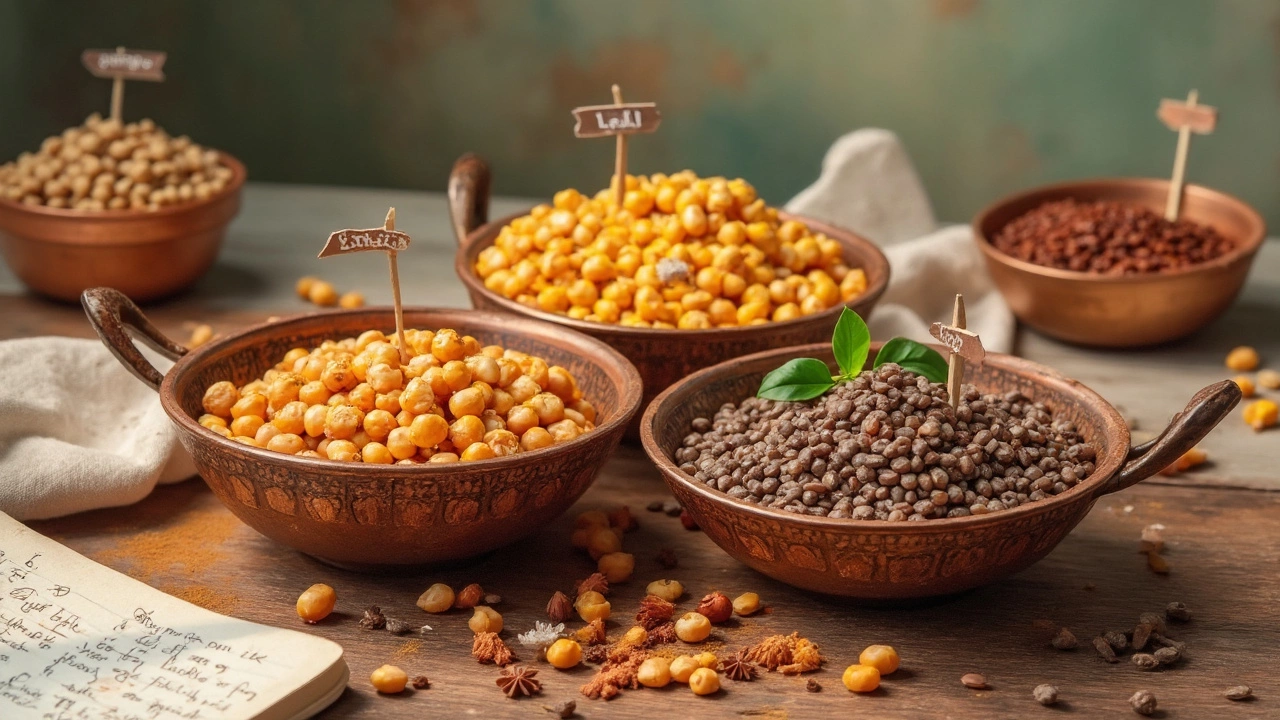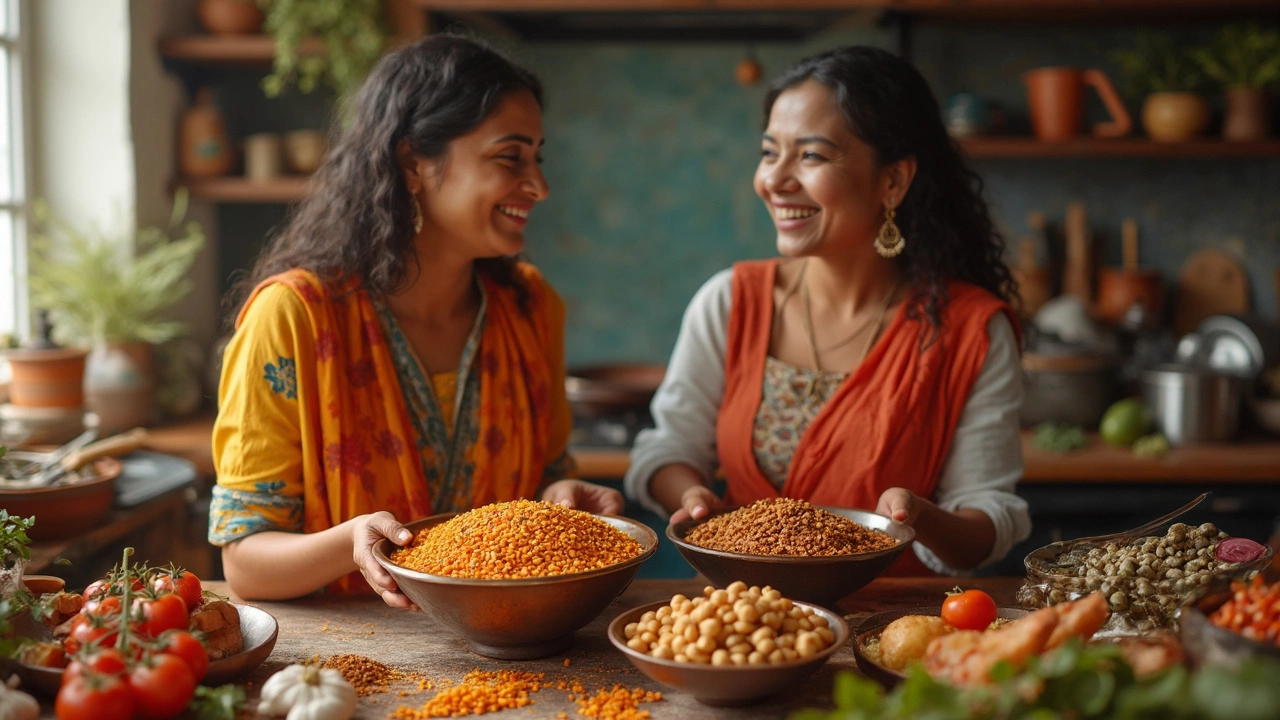Grab a bag of chickpeas or lentils and you’ll notice two things right away: they look a bit different, and they cook up even more differently. But if you’ve ever stood in the store wondering which one you should use for your next simple dal recipe, you’re definitely not alone.
Here’s the thing—both chickpeas and lentils pack plenty of plant protein and fiber. They’re also easy on your wallet. But that doesn’t mean they do the same job in your meal or even in your body. If nutrition matters to you, or if you’ve got specific goals like more iron or easier digestion, your choice could change the outcome. Same for texture: some folks love the bite of chickpeas, while others want that classic, creamy daal feel lentils give.
If you want to make your weeknight cooking even simpler, understanding how these two powerhouses work can help you shortcut soaking times and get to eating faster. Ready for some quick facts and less confusion next time you’re prepping dal? That’s what we’re tackling right here.
- Nutritional Face-Off
- Taste and Texture Differences
- Ease of Cooking and Versatility
- Choosing What Works for You
Nutritional Face-Off
When it comes to nutrition, chickpeas and lentils both bring a lot to the table, but they aren’t twins. Their benefits depend on what you need most out of your meal. Here’s a head-to-head look at the basics per cooked cup (about 160-200g):
| Chickpeas | Lentils (Brown/Green) | |
|---|---|---|
| Calories | ~270 | ~230 |
| Protein (g) | 14.5 | 17.9 |
| Fiber (g) | 12.5 | 15.6 |
| Iron (% RDA) | 26% | 37% |
| Folate (% RDA) | 71% | 90% |
| Fat (g) | 4.2 | 0.8 |
Chickpeas have a little more fat, mostly the good kind, while lentils edge them out in protein, fiber, and key minerals. If you track protein for workouts or iron for energy, lentils might have your vote. They’re also a powerhouse for folate, which is key if you’re pregnant or just want sharper memory.
Chickpeas shine with their heart-healthy fats and are slightly higher in calories—which isn’t always a bad thing if you need something filling. Lentils, being lower in fat, fit well if you want something lighter that keeps you full longer. Both lower cholesterol and help with blood sugar, but lentils may give blood sugar a gentler ride thanks to their fiber and lower glycemic index.
If you’re watching sodium, both are naturally low, unless you’re reaching for canned chickpeas or pre-cooked lentils where salt sneaks in. Rinse canned beans well to lower salt, or grab dried for full control.
Here’s the simple takeaway: if you want more protein and fiber with fewer calories, lentils win. If you want some healthy fats and a bit more energy in your meal, chickpeas are your go-to. Either way, you’re making a smart, healthy pick for your next dal.
Taste and Texture Differences
If you've ever eaten both a chickpea curry and a classic lentil dal side by side, the textural difference jumps right out. Chickpeas (also called garbanzo beans) hold their shape even after hours of simmering. They're a little nutty, a bit chewy, and add a nice bite to any dish. Lentils cook down much faster and lose their shape, creating that signature creamy base you find in most traditional dal recipe bowls.
Here’s the rundown on how each feels and tastes in simple dal dishes:
| Legume | Texture After Cooking | Flavor Notes | Best For |
|---|---|---|---|
| Chickpeas | Firm, holds shape | Nutty, earthy | Hearty dals, salads, stews |
| Lentils (red, yellow, or brown) | Soft to mushy, thickens into puree | Mild, a bit peppery or earthy depending on type | Classic creamy dal, soups |
Here are a few more tips to help you pick for that perfect bowl:
- If you want a dal that’s thick and smooth, lentils are your friend. Split red or yellow lentils break down quickly into a soft, rich texture. That’s why they’re a go-to for a simple, creamy dal.
- If you want bite in every spoonful, chickpeas win out. You’ll need to soak and cook them longer, but their meaty texture makes any dal feel filling and substantial.
- Don’t forget the blend option: combine both! Use some cooked chickpeas for texture and lentils for creaminess. This trick shows up in Punjabi recipes like dal makhani (though that one uses black lentils plus kidney beans).
If you’re new to Indian dals, try starting with lentils for that classic, comforting vibe. Want to branch out? Toss in chickpeas for a chunkier meal.

Ease of Cooking and Versatility
Lentils and chickpeas don’t act the same in the kitchen, and that can make or break a dal recipe—especially when you’re running short on time. Here’s the lowdown:
Lentils: Most lentils (like moong, masoor, and toor) cook up super fast. On the stove, you can have them ready in 20 to 30 minutes. Some, like split red lentils, soften in barely 15 minutes with no soaking needed. That’s a lifesaver on busy nights. Bonus: you can toss them straight into soups or curries—no soaking, no planning.
Chickpeas: These guys are tougher. Dried chickpeas usually need soaking for at least 8 hours, or overnight, unless you want to chew all day. Then, they still take 45 minutes to an hour to get soft on the stovetop (or about 20-30 minutes in a pressure cooker). Canned chickpeas are a total shortcut, though—just rinse and they’re ready to use.
| Legume | Soaking Needed | Average Cooking Time | Best Quick Option |
|---|---|---|---|
| Red Lentils | No | 15-20 mins | Stovetop |
| Toor/Masoor Dal | No | 25-30 mins | Stovetop |
| Chickpeas (Dried) | Yes (8+ hrs) | 45-60 mins | Pressure Cooker |
| Chickpeas (Canned) | No | 5 mins (heating) | Canned |
Want more options in the kitchen? Lentils play along with nearly any spice or flavor—seriously, there’s almost nothing they won’t go with. You can make dal, toss them on salads, blend for a creamy soup, or even use them in veggie patties. Chickpeas are no slouch in this department, either. They’re the main deal in chana masala, but they’re also great in salads, roasted for snacks, or mashed for hummus.
- Tip: Stash canned chickpeas and a bag of split lentils in your pantry. You’ll never be more than 30 minutes from a protein-packed meal.
- Swapping in lentils for chickpeas (or vice versa) is totally doable, but expect a different feel—lentils break down, chickpeas stay chunky.
So, if your schedule is tight, lentils are hands-down quicker. But if you want something with more bite and you’ve got some time (or a can opener), chickpeas keep things interesting.
Choosing What Works for You
This part comes down to what you need from your food and how you actually cook at home. Some people want the quickest meal, with no fuss. Others care about nutrition numbers, or maybe just want a dal that tastes like what their grandma made. Here’s how to decide.
If you’re watching protein or iron, here’s a quick side-by-side of the basics (for 100g cooked):
| Chickpeas | Lentils | |
|---|---|---|
| Calories | 164 | 116 |
| Protein (g) | 8.9 | 9.0 |
| Fiber (g) | 7.6 | 7.9 |
| Iron (mg) | 2.9 | 3.3 |
| Cooking Time | 1-2 hours (without pressure cooker) | 20-30 minutes |
Protein and fiber are just about even, so that’s not a game-changer. But lentils edge out chickpeas when it comes to iron, and they really win if you don’t want to stand by the stove forever. Chickpeas, though, hold their shape better and can be a great meat substitute if you like a chunkier dal.
Take these quick tips when picking between them:
- Short on time? Go with lentils—they’re the weeknight hero.
- Want a nutty, meaty bite? Chickpeas will give you that chunky texture.
- Aim for higher iron? Lentils win, especially if paired with a squeeze of lemon (vitamin C boosts iron absorption).
- Digestive comfort a must? Lentils are usually easier for sensitive stomachs. Soaking either overnight will help, but lentils are just gentler for most people.
- Love creamy meals? Red or yellow lentils break down into that classic mushy dal, while chickpeas never quite get there.
If you like to meal prep, cook extra and freeze. Both chickpeas and lentils freeze well, but lentil dal reheats a little softer. Oh, and if you’re really curious—mix them up in your next pot. Some of the tastiest dals use both, giving you the best of both worlds.
